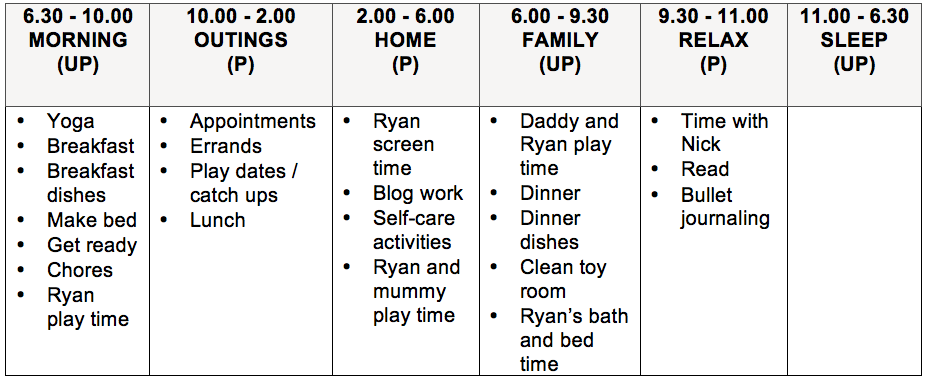How to use time blocking to be more productive

I feel like I’m constantly thinking about ways that I can better utilise my time. Whether it’s time spent with Ryan, time getting things done in the house, and even time to do something for me, some days I feel like I don’t have a good balance of anything.
However, I recently watched this YouTube video about the block schedule system, and it immediately felt like something that would help me reach the daily productivity levels that I was after.
I’ve since started planning my days in time blocks, and here’s how it works:
What is time blocking?
The block schedule system (or commonly used term time blocking), is where you schedule your daily to dos and activities into 2 – 4 hour blocks of time.
Before I started planning my days in blocks of time, I would get through my to do list, task by task, and plan Ryan’s catch ups and activities at any stage throughout the day.
I quickly found that by doing this I wasn’t getting a lot done. I procrastinated on a lot of tasks that I just didn’t want to do (like fitting yoga into my day), and that Ryan would nap too late in the car if we were out later in the afternoon.
I love a schedule, I love lists, and I love planning out my days. So making my days more structured, and slotting my daily to dos and activities into set time blocks, is something that I’ve now tried, and love.
Advantages of using time blocking
The advantages of planning your day according to time blocks are:
- By grouping similar tasks together, and working on them at the same time, it becomes easier to get through them because you can focus your thoughts on similar issues that may arise
- Our schedules are very similar each day, even if what we have to get done isn’t. By having time blocks you can easily slot new to dos into your day
- You can plan your time blocks according to your energy levels. For example, I schedule my outings for 10am onwards, as Ryan likes to chill out at home before that time
How to use time blocking to become more productive
If you’re interested in time blocking, here are the steps that I took to implement it into my days:
1 List your daily activities
The first step you should take to start time blocking your day is to make a list of the to dos and activities that you have over a typical day.
To dos and activities that happen over the course of a typical day for me include:
- Appointments
- Blog work
- Bullet journaling
- Chores
- Clean meal dishes
- Clean toy room
- Daddy and Ryan play time
- Errands
- Getting ready
- Making bed
- Meal times
- Play dates / catch ups
- Reading
- Ryan and mummy play time
- Ryan play time
- Ryan screen time
- Ryan’s bath and bed time
- Self-care activities
- Time with Nick
- Yoga
2 Group similar activities
Once you have your list, group similar to dos and activities together.
Here are two examples of this using my list of to dos and activities:
Chores
Clean meal dishes
Making bed
Meal times
Appointments
Errands
Play dates / catch ups
3 Create your time blocks
Now that you’ve grouped similar to dos and activities together, it’s time to create your time blocks, give your time blocks a name, and slot your to dos and activities into them.
This is where the magic happens, and for me, where the block schedule / time blocking system made perfect sense in increasing my productivity levels.
Here’s my daily time blocking schedule:

Underneath the name of each time block you’ll see (UP) or (P), this means that the block of time will be either unplugged (I won’t be using my phone), or plugged (I will be using my phone).
Since increasing the amount of unplugged time I have throughout the day, I’ve been able to focus on Ryan more, and when I do get the chance to have some blog time, I get more done as I’m not as distracted.
Whilst no two days for anyone are often the same, time blocking allows us to easily slot something new into our days, in a time that we can best deal with it.
My final thoughts
Take your time to decide the length of time that your time blocks should be. For example, if you find that the time you’ve dedicated to your mornings isn’t long enough, or too long, then make changes. It’s all about finding what works best for you, and that may take some time to discover.
Also, make sure you schedule some downtime into your day, even if it’s just 20 minutes, that way you can have an all rounded day.
Lastly, you don’t have to follow your time blocks every day. There may be days where you’re at a work training session all day and there’s no room for anything else. There may be days where you just don’t want to be locked into a schedule. Or, you may decide not to time block on weekend.
What do you think about planning your day in blocks of time?






I’ve never tried this, but it certainly makes a lot of sense! Great pointers.
Thank you so much! It’s definitely worth a try. It can seem like a bit of work at the start trying to work out how long you want your time blocks to be, and what tasks you want in them, but once you figure it out it makes planning your day so much easier. If you give it a go I’d love to hear how you go.